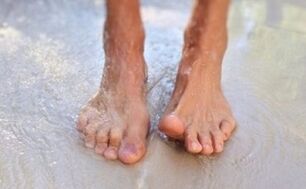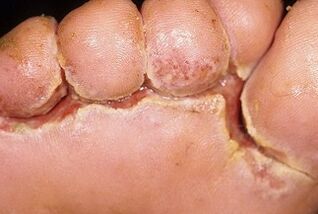About 80% of the population is affected by skin fungus. Due to the increase in density and sweating, mycoses are more affected by the skin on the feet. Fungal infection is manifested by skin and itching, but can also be asymptomatic, causing only the appearance of seals (calluses, corns - hyperkeratosis on the heels and arches of the feet). If left untreated, the infection spreads. The patient can infect others, spreading germs throughout his body.
Where did the mushroom come from

Fungal microorganisms love a moist and warm environment and a large amount of nutrients. As a "shelter" they use dense skin, prone to increased fat secretion and sweat.
Human feet - always act as a breeding ground for mycobacteria, and poor quality socks and shoes contribute to this.
You can get infected in a public place - on the beach, in the sauna, in the pool. You can bring the infection when you try on new shoes because the day before, a person with foot mycosis could measure it.
Some internal factors also increase susceptibility to fungi:
- weakened immunity - fungi refuse the body's defenses, when they are weakened, it is easier for microorganisms to penetrate the skin;
- endocrine disorders - diabetes mellitus and hormonal imbalances change the composition of skin secretions, turning them into a breeding ground for bacteria;
- persistent damage - cracks, cracks, scratches and drilling can be the gateway for the fungus;
- lack of hygiene - poor quality foot washing, use of dirty socks and airtight shoes contribute to fungal invasions on the limbs.
Infection is also possible from a loved one - whether there is a patient at home or a fungal carrier with an asymptomatic course of the disease. Disputes of pathogenic microorganisms spread to household appliances, personal belongings, gender (if the patient moves barefoot). When you wash the belongings of all the inhabitants of the house, mycobacteria get into the clothes of healthy family members, they can provoke fungal infections not only on the feet, but also on other parts of the body (in the folds, hips, hair areas)of the body).
Why fungi appear between the toes
Interdigital fungi are a special clinical form of foot mycosis. Doctors call it intertriginous. With this course, the skin is touched between 3 and 4 or 4 and 5 fingers. Often, the pathological process begins in one limb, and eventually spreads to a healthy one.

Mycosis begins with the cracking of the skin between the toes or at the base of the phalanx of the foot. The size of the lesion can be from 2-3 mm to 1 cm. The intensity of the symptoms depends on the area of the wound - the greater the damage, the stronger the pain. At the time of the appearance of the crack, the person experiences slight discomfort while walking, which increases with hygiene procedures.
Unlike other injuries, the crack does not heal on its own. It becomes inflamed, excretes feces. The surface between the fingers becomes wet, which further contributes to the spread of the fungus to larger areas of the skin. A "fringe" appears around the injury - it is steamed skin. The detachment is quite thick, attempts to remove it with the fingers end in damage to healthy areas of the skin. Persistent peeling appears around the lesion. It can be lamellar or meal. The scales are silver, white, yellow. These characteristics depend on the strain of the fungi infecting the skin. Once the crack heals, the intriguing form of the fungus turns into squamous - it appears as wide dry areas on the foot, with an abundance of exfoliated scales. The surface may be glossy or tissue-like.
What to do with fungal symptoms
If you have a crack between your fingers surrounded by loose skin, you should definitely see a dermatologist. The specialist will perform an examination, will determine the symptoms not only at the site of injury, but also in other parts of the limbs.
Diagnosis cannot be made solely on the basis of symptoms. A microscopic examination of the scratched skin of the foot will be required to confirm the fungus. In the case of resistant mycosis, it is supplemented by PCR analysis or culture inoculation to determine the type of pathogen and its susceptibility to fungicidal drugs.
In advanced cases of fungus or extensive lesions of the dermis, systemic medications will be required. Due to the possibility of hepato- and nephrotoxic effects of such drugs, the patient should undergo blood and urine tests. Based on their results, the specialist assesses the function of vital organs, selects a treatment regimen with systemic antifungals.
Self-medication for fungal infections of the feet is permissible only in the early stages. You can switch to topical medications that do not give systemic side effects.
Effective remedies against interdigital fungi
The characteristics of the therapy depend on the individual data of the patient, the degree of mycosis, the area of the lesion, the presence of a secondary infection or the resistance of the pathogen.
Systemic drugs
To speed up the treatment and make it complete, doctors prescribe antifungal agents in the form of tablets or capsules.
When treating with systemic action medications, it is undesirable to consume alcohol, fatty foods and other foods that create a load on the liver. If the infection has spread to the nails from the interdigital space, longer use of antifungals will be required.
Local remedies
For the treatment of interdigital fungi, medicines are prescribed on a moderately oily or non-greasy basis (creams, solutions). Oils can be used only in the initial stage when softening the skin is necessary for the rapid healing of lesions. Along the way, antifungal medications can be prescribed healing and antiseptic agents. They speed up the regeneration process and soften rough skin.
For the treatment of foot fungus, external agents with broad-spectrum fungicidal ingredients are prescribed. Ideal for products based on:
- terbinafine;
- clotrimazole;
- ketoconazole;
- econazole;
- naftifina.
Price does not affect the success of treatment, it is important to choose the correct active ingredient of the drug.
Creams and solutions are applied to the skin 1-2 times a day after hygiene procedures. After processing, the product is allowed to soak completely and wear cotton socks. In parallel, it is necessary to disinfect shoes every 3-7 days. For this, fungicidal sprays are used. Regular replacement of socks, underwear, towels is required. It is necessary to wash used items at elevated temperatures separately from other accessories of the patient and his family members.
With trichophytosis and microsporia, doctors recommend special treatment regimens. For example, treatment with iodine solution in the morning and sulfur, sulfur or salicylic ointment in the evening.
Folk remedies
You can not be treated for a fungus only by popular methods. Baths are allowed in addition to medication. If the doctor advised the application of ointments or home-made formulations, they should be used separately from pharmaceutical preparations. For example, in the morning and evening, use a ready-made medicine, and in the afternoon - homemade oil. The most popular methods of treating fungi among humans:
- oak bark baths- make a large volume of broth from oak bark (6 tablespoons per 1 liter), dilute in half with clean water, take baths for 15 minutes a day;
- with sea salt- prepare a strong solution of sea salt, take a shower for 10 minutes, do not wash the salt, put on cotton socks immediately after the procedure;
- me soda- dilute a tablespoon of soda in 1 liter of water, take a bath for 15 minutes, after wiping, apply antifungal pharmaceutical agents;
- egg ointment- 1 chicken egg is mixed with a tablespoon of oil and vinegar, mixed until smooth, applied for 3-4 hours under the bag, washed with water;
- tea trees- The areas affected by the fungus are lubricated abundantly with tea tree essential oil, washed after 3 hours, sensitively, the oil is diluted half with neutral fats.
A quick cure of fungus is facilitated by the rejection of sweets, alcohol, fatty foods. The patient's diet should contain lots of vegetables, fermented milk products, whole grains.
To prevent fungus on the feet and between the toes, you need to take good care of the hygiene of your feet. When visiting a public place, avoid walking barefoot, use fungus prevention tools - any ointment or antifungal spray is applied after the shower. New shoes should only be measured in new socks; you should not give your slippers to anyone.
























